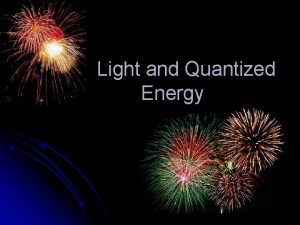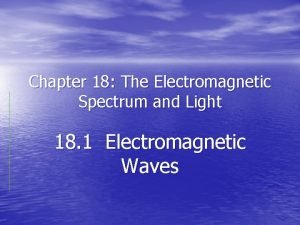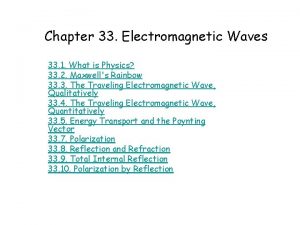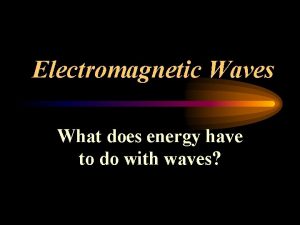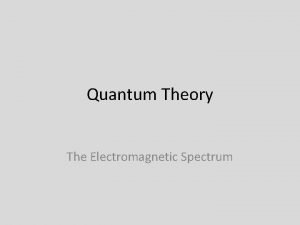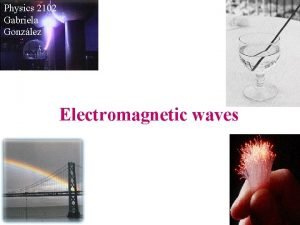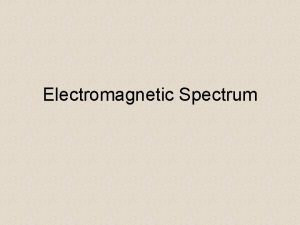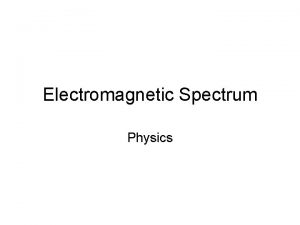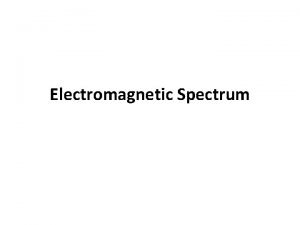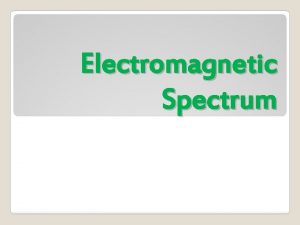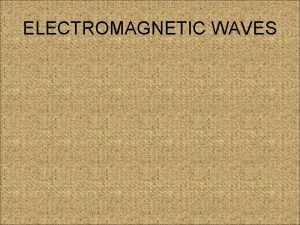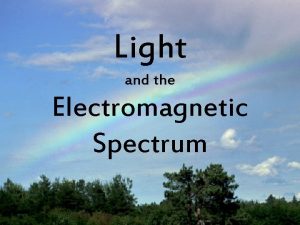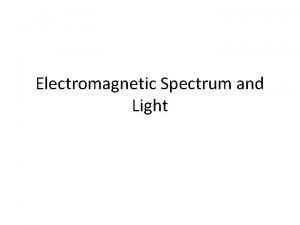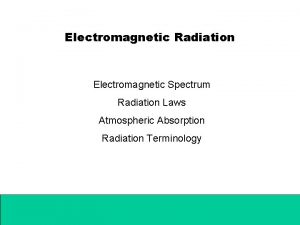Electromagnetic Radiation 3 Light and the Electromagnetic Spectrum












- Slides: 12

Electromagnetic Radiation 3 – Light and the Electromagnetic Spectrum

1. No matter where you are, you are surrounded by invisible waves. a. Even though you cannot feel them, some of these waves are travelling right through your body. i. E. g. radio waves, microwaves, ultraviolet waves

2. The Sun is the most important source of light on Earth. a. Light spreads out, or radiates, from the Sun and other stars in all directions, like the spokes of a bicycle wheel. i. Energy, such as light, that travels by radiation is often called radiant energy. b. In addition to the visible energy that we call light, the Sun also radiates invisible energy. i. The light we see is just a tiny band of a much broader spectrum of energy

3. Light is a different kind of wave from those that travel through water. a. In a water wave, water particles vibrate up and down as the wave passes through the water. b. In a light wave, electrical and magnetic fields vibrate. i. As a result, light is classified as electromagnetic radiation. c. Visible light energy and all the invisible forms of radiant energy exist on the electromagnetic spectrum d. Electromagnetic radiation is the transmission of energy in the form of waves that extend from the longest radio waves to the shortest gamma rays. i. Various devices have been developed to detect other frequencies. • E. g. the antenna of your radio detects radio waves.

4. Radio waves are a type of electromagnetic radiation that have the longest wavelength and lowest energy and frequency compared to all other types. a. Different wavelengths of radio waves have different uses i. E. g. radio and television broadcasting ii. E. g. Microwaves and radar are types of radio waves

b. In magnetic resonance imaging (MRI), a patient lies in a large cylinder that is equipped with a powerful magnet, a radio wave emitter, and a radio wave detector. i. Particles in the bones and soft tissues behave like tiny magnets and can be lined up. ii. When the MRI machine causes the orientation of the particles to flip, they produce radio waves. • The released energy is detected by the radio receiver and used to create a map of the different tissues

c. Microwaves have the shortest wavelength and the highest frequency of all the radio waves. i. Microwave ovens use a specific wavelength (or frequency) of microwave that is strongly absorbed by water particles. • When the water particles in the food absorb microwaves, they begin to vibrate quickly and become hot. • Only foods that contain water particles can be heated using microwaves. ii. Microwave frequencies are also used in telecommunications • Microwaves can be transmitted to telecommunications satellites that orbit Earth. • Some radio telescopes are directed toward distant planets and galaxies to learn more about the composition, motion, and structure of these distant objects.

d. Shorter wavelength microwaves are used in remote sensing, such as radar. i. Microwaves are beamed out through the air. • The waves that reflect from an object can show the location and speed of the object. ii. Radar is used for tracking the movement of automobiles, aircraft, watercraft, and spacecraft. iii. Raindrops, snow crystals, and other objects in the air reflect radio waves. • Doppler radar, electronically convert the reflected radio waves into pictures that show the location and intensity of precipitation and the speed of the wind.

4. Infrared waves are a type of electromagnetic radiation that, relative to light, has a longer wavelength and lower energy and frequency. a. A remote control emits infrared waves to control a television set. b. Infrared radiation is also referred to as heat radiation. • Every object emits some infrared waves because all objects contain some heat energy. • Warmer objects emit more infrared waves than cooler objects

5. Ultraviolet waves are a type of electromagnetic radiation that, relative to light, has a shorter wavelength and higher energy and frequency. a. This radiation is very energetic. b. Ultraviolet radiation striking your skin enables your body to make vitamin D, which you need for healthy bones and teeth i. Overexposure to ultraviolet radiation can result in sunburns and skin cancers, and damage to the surface of the eye. c. Fluorescent materials absorb ultraviolet waves and emit the energy as visible light. i. Police detectives sometimes use fluorescent powder to study fingerprints when solving crimes. ii. Ultraviolet waves are also able to kill bacteria in food, water, and medical supplies.

6. X rays are a type of electromagnetic radiation that have a much shorter wavelength and higher energy and frequency than ultraviolet waves. a. Doctors and dentists use low doses of X rays to form images of internal organs, bones, and teeth. b. Airport security personnel use X-ray screening devices to examine the contents of luggage. c. X rays can also be used to inspect for cracks inside high performance jet engines without taking the engine apart, and to photograph the inside of machines

7. Gamma rays are the highest energy and frequency and shortest wavelength portion of the electromagnetic spectrum. a. Gamma rays result from nuclear reactions and are produced by the hottest regions of the universe. b. Focussed bursts of gamma rays are used in radiation therapy to kill cancer cells.
 Types of radiation in the electromagnetic spectrum
Types of radiation in the electromagnetic spectrum Electromagnetic.spectrum
Electromagnetic.spectrum Chapter 18 electromagnetic spectrum and light
Chapter 18 electromagnetic spectrum and light Longitudinal vs transverse wave
Longitudinal vs transverse wave Copper orbital diagram
Copper orbital diagram Light light light chapter 23
Light light light chapter 23 Into the light chapter 22
Into the light chapter 22 Light light light chapter 22
Light light light chapter 22 Absorption spectrum vs emission spectrum
Absorption spectrum vs emission spectrum Intensity of electromagnetic radiation
Intensity of electromagnetic radiation Facts about electromagnetic radiation
Facts about electromagnetic radiation Wavelength of electromagnetic radiation formula
Wavelength of electromagnetic radiation formula Intensity of electromagnetic radiation
Intensity of electromagnetic radiation
